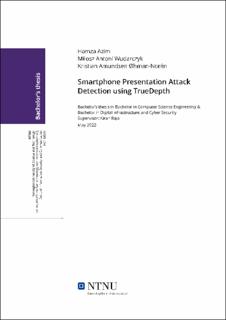| dc.contributor.advisor | Raja, Kiran | |
| dc.contributor.author | Azim, Hamza | |
| dc.contributor.author | Wudarczyk, Milosz Antoni | |
| dc.contributor.author | Øhman-Norén, Kristian Amundsen | |
| dc.date.accessioned | 2022-07-09T17:19:12Z | |
| dc.date.available | 2022-07-09T17:19:12Z | |
| dc.date.issued | 2022 | |
| dc.identifier | no.ntnu:inspera:106261571:112575908 | |
| dc.identifier.uri | https://hdl.handle.net/11250/3004308 | |
| dc.description.abstract | Automatisk angrepsgjenkjenning ved ansikts-autentisering (PAD) er en viktig del
av å kunne beskytte ansiktsgjenkjennings-systemer fra alvorlige potensielle sik-
kerhetsbrudd. I dag eksisterer et flerfoldig antall stabile, effektive og nøyaktige
systemer for PAD. I dagens PAD-landskap er de beste PAD-algoritemene beregnet
for bruk på RGB-bilder. I virkeligheten kan flere dimensjoner og fakorer enn et
standard kamera tas i betraktning når et presentasjons-angrep blir forsøkt oppda-
get.
Forskningen rundt hvor mye slik tilleggsdata kan påvirke prosessen av ansikts-
basert angreps-gjenkjenning er i dag lite utforsket. Ikke en eneste offentlig-tilgjengelig
artikkel har forsket på løsninger for PAD som tar dybde-data fra smart-telefoner i
bruk. Slik dybde-data kan hentes direkte ut fra flere moderne telefoner, deriblant
Apples iPhone, gjennom dens innebygde TrueDepth-sensor. Denne oppgaven tar
for seg forskning rundt hvordan dybde-dataen som kan hentes fra denne typen
sensorer kan effektivt brukes til PAD. Resultatet av denne oppgaven kontribuerer
direkte til den pågående forskningen innen utvikling av fremtidsrettede PAD-
metoder. | |
| dc.description.abstract | Automated Presentation Attack Detection(PAD) is essential to protect facial recog-
nition systems from potential security breaches. A multitude of stable, effective
and accurate PAD systems exist today. In the current landscape within the field
of PAD, the majority of the systems considered to be the most effective, use RGB-
imaging exclusively. In reality, more dimensions and factors beyond the standard
RGB-data produced by a camera can be taken into account when attempting to
stop a presentation attack from happening.
The research on how each type of supplemental data effects the detection
of presentation attacks, is largely unexplored territory. Little publicly available
material has proposed a solution that takes advantage of depth data from mobile
devices. One way this data that can be collected, is by using the widely available
TrueDepth sensor available in the majority of new iPhones being manufactured
today. This thesis focuses on researching how the depth data that is generated
through the use of these sensors can be utilized effectively in PAD. It utilizes a
new, TrueDepth-driven approach to PAD. The results produced in conjunction with
this thesis contribute directly to the currently ongoing research on development
of PAD methods for the future. | |
| dc.language | eng | |
| dc.publisher | NTNU | |
| dc.title | Smartphone Presentation Attack Detection using TrueDepth | |
| dc.type | Bachelor thesis | |
